Michigan State Police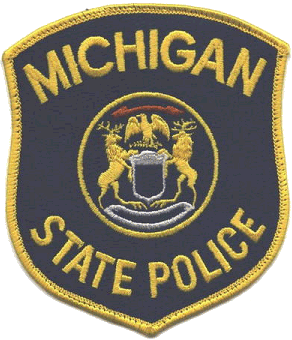
Michigan State Police
The Michigan Department of State Police began as a temporary, wartime emergency force for the purpose of domestic security during World War I. On April 19, 1917, the Michigan State Troops Permanent Force, (also known as the Michigan State Constabulary) was created.
This new force consisted of five Troops of mounted, dismounted and motorized units, totaling 300 men. On March 26, 1919, Public Act 26 reorganized the Constabulary as the permanent, peace-time Michigan State Police. In 1924, an expanded fleet of Indian and Harley Davidson motorcycles were introduced to highway patrol including in the Winter (with use of sidecars of course).
In 1930, the black uniform was replaced with the familiar blue and gray uniform. After the end of World War II, General Douglas MacArthur requested the help of the Michigan State Police in reorganizing the Japanese national police as a democratic, civil police force. A high honor indeed for the MSP! By 1956, the ranks of the MSP swelled to 1000 for the first time.
In 1965, the MSP was reorganized and was one of 19 departments provided by the new state constitution. Today, the Michigan State Police consists of a modern-day force of over 3000 civilian and law enforcement professionals, using the latest up-to-date training and technology to protect the citizens of Michigan.
There are 65 MSP Posts throughout the Great Lake State and many elements of logistical support including canine, aviation and crime labs to name a few. Marked patrol vehicles of the MSP still bear the single red rotator rooftop light, some call the "tomato can".
It is one of the few agencies in North America that still uses this older style overhead light. What was once a cavalry of 300 men now has evolved into one of the leading police agencies of the United States, truly reflective of the MSP's motto: "A Proud Tradition of Service Through Excellence, Integrity and Courtesy".
The Michigan State Police holds the distinct honor of having issued the earliest dated state agency-specific license plates in North America. The earliest known license plate used by the MSP was issued in 1919-1920 but was not dated.
The 1919-1920 license plate was an embossed steel plate measuring approximately 5 1/2" x 11" and painted white over black. A large numeral occupied the left side of the plate with STATE over POLICE occupying the remainder of the plate. It is unknown if these plates were issued as a single or in pairs. We are in dire need of a photo of one, so your help in this regard would be GREATLY appreciated!
Of particular interest, these earliest patrol cars of the MSP were seized from bootleggers and other criminals of the prohibition era. The MSP didn't begin purchasing fleet patrol vehicles until 1933.
In 1922 a photo is known to exist showing an MSP car with a standard Michigan license plate gracing the front end, number 31-283. It is possible that the previous issue plate was also a standard passenger series number.
The photo seen below, provided by the Michigan State Police is the earliest photo known (so far) of a dated state agency-specific license plate. The plate was painted in white over black and measured approximately 5" x 11". It had a stylized die known as a cipher of MICH over 24 down the left side of the plate. A large numeral die occupied the right margin of the plate. (There were 20 cars in the MSP fleet in 1920). The word STATE was embossed over POLICE and over DEPT. PUBLIC SAFETY in smaller embossed dies.
There is no known 1925 issue, however it can be surmised that the white over black color scheme continued as did the format and layout.

 Close-Up of 1924 MSP license plate.
Close-Up of 1924 MSP license plate. 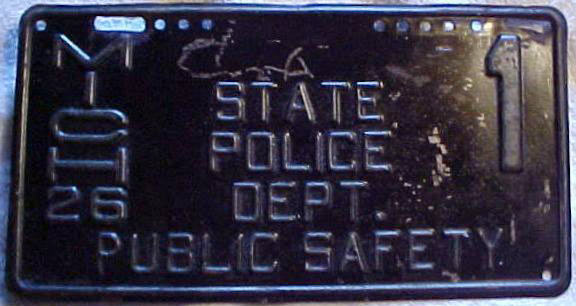 1926 issue. Embossed steel. Approximately 5 1/2" x 11 1/2".
1926 issue. Embossed steel. Approximately 5 1/2" x 11 1/2".
A 1926 MSP license plate was uncovered in 2012 bearing the Commisioner's number 1 which is shown and described above. The oddity of this plate is the unusual multiple circular mounting holes occupying the top of the plate. It is likely that this number was due to the many different mounts used by the various seized bootlegging cars.
There are no 1927 and 1928 MSP license plates known, but likely followed the same coloring and format as the previous issues.
In 1929, a formatting change took place. The plate still appears to be approximately 5 1/2" x 11 1/2" and embossed steel in white over black.The top of the plate had the words STATE POLICE embossed over DEPARTMENT embossed over PUBLIC SAFETY the state name MICHIGAN was spelled-out in full along the bottom margin followed by the year 1929. A number up to 2 digits occupied the far right margin of the plate and only made with four mounting holes.
This layout and format for MSP license plates continued until 1934 when the size changed to 5 1/2" x 13 1/4". The words DEPARTMENT and PUBLIC SAFETY were dropped. The top center of the plate had MICHIGAN flanked on the left by 19 and 34 to the right. The title STATE over POLICE was embossed on the far left of the plate and an embossed numeral up to 2 digits occupied the center and right portion of the plate. This format allowed for the expansion of the fleet to a number above 100.
The 1935 issue followed suit but with 19 MICHIGAN 35 at the bottom of the plate.

 1929 issue # 43.
1929 issue # 43.

 1930 issue. Embossed thin steel.
1930 issue. Embossed thin steel. 


In 1930, the Sparks-Withington Company of Jackson Michigan were the manufacturers of the Sparton Radio among other automotive items.
That year, the company deployed a number of cars for police agencies in Michigan equipped with their new Sparton Police Radio.
The Michigan State Police entered into an arrangement with the company to undergo a trial run of the Sparton Police Radio that was installed in a stunning Lincoln sedan and run on duty for 1931.
This radio trial with the provided car was believed to have lasted until at least 1932.
The Sparton Police Radio MSP Lincoln sedan that was provided came equipped with special livery markings for the MSP and fastened to the rear of the vehicle was a 14 inch rectangular embossed metal plate that read: SPARTON POLICE RADIO over PROPERTY over STATE OF MICHIGAN.
Nobody knows what became of the Sparton Police Radio or the attractively-adorned Michigan State Police Lincoln, however fast forward to a barn in the Lansing area over the next several decades.
This 14 and a half inch by 4 inch license plate devoid of any original paint seen below was residing there those many decades before changing hands and eventually ending up being found at a garage sale in Haslett Michigan. The man who found and bought that curious piece of embossed metal on August 4 2023, was C J Duffield who was kind enough to share this rare treasure that although is not a Michigan State Police license plate "per se", was certainly a part of MSP license plate history.
It only took 92 years to go from forgotten obscurity to a treasured piece of that Michigan State Police history.
 1931 Sparton Police Radio license platethat was affixed to rear of the special "Trial Run" MSP Lincoln seen below. Embossed steel.
1931 Sparton Police Radio license platethat was affixed to rear of the special "Trial Run" MSP Lincoln seen below. Embossed steel. Special livery markings on the Sparton Police Radio MSP Lincoln
Special livery markings on the Sparton Police Radio MSP Lincoln 1931 MSP Lincoln patrol car provided by the Sparks-Withington Company for the MSP trial-run of the Sparton Police Radio.
1931 MSP Lincoln patrol car provided by the Sparks-Withington Company for the MSP trial-run of the Sparton Police Radio. 1936 proved to be an unusual year as TWO variations of MSP license plates were issued that year.
The first one followed the same format as the 1934 issue with 19 MICHIGAN 36 positioned at the top of the plate. This was the earlier version with lower assignment numbers.
The second version had 1936 MICHIGAN embossed at the top over STATE over POLICE on the left portion of the plate and an embossed number up to 3 digits. The color was still white over black.
In 1937, the same layout continued but with 1937 MICHIGAN positioned along the bottom of the plate.
1938 saw the state name shortened again to MICH 38 at the top of the plate over the STATE over POLICE on the left side followed by the embossed numeral up to 3 digits.



1939 had 19 MICH 39 at the bottom of the plate followed by the same format as the previous issue.
 1940 issue. Embossed steel.
1940 issue. Embossed steel. 

In 1941, the plate was identical to the 1940 issue with only MICH 41 being the difference.
In 1942, the design changed again to feature the state name spelled out in full along the top center of the plate. STATE over POLICE was still embossed on the left side but now followed by a vertical embossed dash followed by a number up to 3 digits. 42 was embossed at the bottom center of the plate. This plate was believed to have been used through 1944 in an effort to conserve metal during the War effort at the time.
 1942-1944 issue. Embossed steel.
1942-1944 issue. Embossed steel. 
 1945 issue. Embossed steel.
1945 issue. Embossed steel. 
In 1946, the size of the plate changed to 6" x 13 5/8". The color combination of white over black continued and the state name occupied the bottom of the plate while 46 occupied the top center.
1947 saw the switch of the state name and year again with MICHIGAN at the top of the plate and 47 at the bottom center.
1949 saw the switch of the state name and year again with 49 at the top center of the plate and MICHIGAN at the bottom center. This plate was also a multi-year usage for metal conservation during the Korean War. It was used until 1953.
 1947 issue. Embossed steel. Approximately 6" x 13 5/8".
1947 issue. Embossed steel. Approximately 6" x 13 5/8". 


In 1953, a municipal exempt license plate was used by the MSP. The color was once again white over black and measured 6 1/2" x 14 1/4". The state name MICHIGAN was embossed at the top center of the plate, and 53 was embossed at the bottom center. The distinctive debossed "X" inside a white diamond prefaced a 00-000 serial format beginning with the number 14. Plate number 14-119 was confirmed run on MSP car # 119 in 1953. The plate also featured an unpainted border with debossed slots top and bottom. The number 14 prefix was used for MSP designation on state government license plates issued for MSP service and support vehicles for many years thereafter.
The municipal exempt license plates with a 14 prefix were continued for the MSP in 1954. The color had changed to the maize yellow over dark blue color scheme in recognition of the University of Michigan.
The top of the plate had the state name MICHIGAN centered with 19 flanking the left top corner and 54 on the right top corner. The distinctive debossed "X" inside a white diamond prefaced a 00-000 serial format beginning with the number 14. The slogan WATER WONDERLAND was embossed along the bottom margin of the plate. Plate number 14- 116 was confirmed run on MSP car # 116 in 1954, and plate number 14-341 as seen in photo below.
This was also the year that the MSP went from black patrol cars to dark blue.

By September of 1954, the Michigan Secretary of State's office issued a new MSP titled license plate to be run rear only on the MSP patrol vehicle. The plate was the same measurement and color as the 1954 municipal exempt and passenger license plates but were undated. Only the state name occupied the top center of the plate followed by STATE over POLICE debossed inside a raised rectangle named by some as a "box". A number up to 3 digits occupied the right center of the plate above the slogan WATER WONDERLAND embossed along the bottom of the plate.
This design set the pace for MSP license plates for the next 50 years.
In the March-April 1955 issue of the MSP magazine "Post-er", new MSP license plates were announced for the marked fleet which were to take the opposite color scheme of the 1954 issue. The yellow background was not well-received by the rank-and-file as they were dubbed "pukish yellow" plates.
Two different yellow backgrounds were used, one a more mustard-yellow as seen by plate #100 seen below and the other a brighter yellow as seen by plate # 802. These plates were run from 1955 to 1958. They were initially issued rear only but by 1957 were being issued in pairs.
 1955-1958 issue. Dark blue over maize. Embossed steel measuring approximately 6" x 13 5/8".
1955-1958 issue. Dark blue over maize. Embossed steel measuring approximately 6" x 13 5/8".  1955-1958 issue. Dark blue over maize. Embossed steel measuring approximately 6" x 13 5/8".
1955-1958 issue. Dark blue over maize. Embossed steel measuring approximately 6" x 13 5/8".  (Photo Courtesy of Willie Brown)
(Photo Courtesy of Willie Brown)By 1956, all jurisdictions in North America had switched to a uniform standard size of license plates to measure 6" x 12". Therefore, when the MSP decided to ditch their "pukish yellow" license plates and go back to the reverse color scheme, it was done on the new smaller sizing format.
The new plates were rolled-out in January of 1958 and were maize over dark blue in the same layout as the 1954-1955 issue and using the same WATER WONDERLAND slogan along the bottom margin of the plate.
There is some conjecture as to whether or not the MSP District/Post designation system of numbering MSP license plates began with this base. It was confirmed for the next issue MSP license plates that came out in 1965, so I will defer that information for that particular issuance until I get rock-solid confirmation that proves otherwise.
 1957
1957 1958-1964 issue. Embossed steel
1958-1964 issue. Embossed steel 1958- Plate 437 (Coldwater Post car 7)
1958- Plate 437 (Coldwater Post car 7)
 1958-1964 issue.
1958-1964 issue. 


The Michigan State Police is deployed over 8 Districts (formerly 9). Commencing for certain in 1965, MSP license plate numbers reflected District (First number) and even Post (Second number) assignment which will be outlined below. Over the course of "leaner times" in the early 2000's, many MSP Posts in some Districts have closed or have been amalgamated into others as may be seen by the more current map posted below. The newer Post designations are outlined further down in the chronology.
As of the 1965-1967 and onward issues of MSP license plates, the following is the MSP District and Post allocations I have on record:
DISTRICT 1 POSTS: 11 Lansing, 12 Brighton, 13 Ionia, 14 Ithaca, 15 Owosso, 16 State Capitol
DISTRICT 2 POSTS: 21 Northville, 22 Romeo, 23 St. Clair, 24 New Baltimore, 25 Flat Rock, 26 Ypsilanti, 27 Pontiac, 28 Erie, 29 Metro Detroit
DISTRICT 3 POSTS: 31 Bay City, 32 East Tawas, 33 Bad Axe, 34 Sandusky, 35 Flint, 36 West Branch, 37 Bridgeport, 38 Lapeer, 39 Caro
DISTRICT 4 POSTS: 41 Jackson, 42 Clinton, 43 Coldwater, 44 Blissfield Team, 45 Jonesville, 46 Battle Creek
DISTRICT 5 POSTS: 51 Paw Paw, 52 White Pigeon, 53 Niles, 54 New Buffalo, 55 South Haven, 56 Wayland, 57 St. Joseph
DISTRICT 6 POSTS: 61 Rockford, 62 Reed City, 63 Mt. Pleasant, 64 Grand Haven, 65 Newaygo, 66 Hart, 67 Lakeview
DISTRICT 7 POSTS: 71 Traverse City, 72 Cheboygan, 73 Gaylord, 74 Alpena, 75 Houghton Lake, 76 Cadillac, 77 Manistee, 78 Petoskey, 79 Kalkaska Team
DISTRICT 8 POSTS: 81 Negaunee, 82 Newberry, 83 St. Ignace, 84 Manistique, 85 Gladstone, 86 Iron Mountain, 87 Wakefield, 88 L'Anse, 89 Stephenson, 90 Calumet, (OLD DISTRICT 9 POSTS) 91 Munising, 92 Iron River, 93 Sault Ste. Marie
 1965-1967 issue. Embossed steel.
1965-1967 issue. Embossed steel. 
In 1965, new license plates were issued to the MSP reflecting the state's new slogan of "WATER-WINTER WONDERLAND". The plates were now made of embossed aluminum and colored maize yellow over dark blue in honor of the 150th Anniversary of the University of Michigan.
This was the series where the use of District and Post designations took place with the first number indicating the District and the first two numbers reflecting the Post.
2 digit numbers were to be used by Post Commanders, but some 2 digit plates were also used by Headquarters and support vehicles.
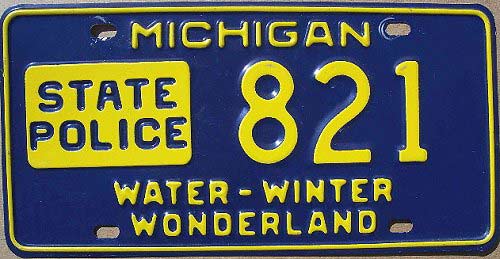 1965-1967 issue. Embossed aluminum.
1965-1967 issue. Embossed aluminum. 
 Older versions of the 1965-1967 issue have a dark blue painted backside (same as front) while newer versions are unpainted
Older versions of the 1965-1967 issue have a dark blue painted backside (same as front) while newer versions are unpainted 1965-1967 issue. Embossed aluminum.
1965-1967 issue. Embossed aluminum.
 1967
1967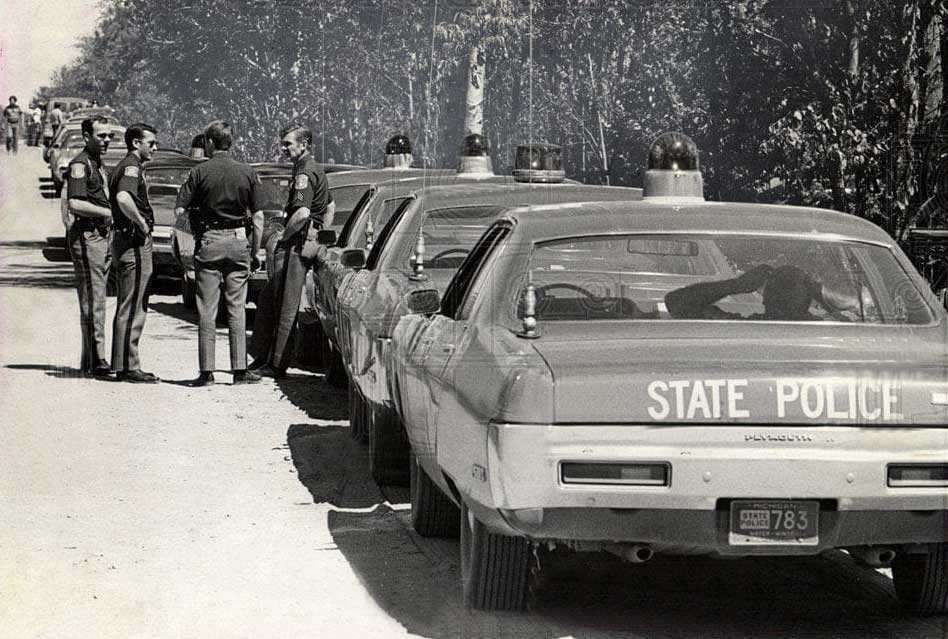
 1968-1969 issue. Embossed aluminum. Use of slogan GREAT LAKE STATE in single line.
1968-1969 issue. Embossed aluminum. Use of slogan GREAT LAKE STATE in single line. 

 1970-1971 issue. Embossed aluminum. GREAT LAKE (over) STATE slogan on bottom. Mounting slots, not circular holes. Flat non-reflective paint for raised characters.
1970-1971 issue. Embossed aluminum. GREAT LAKE (over) STATE slogan on bottom. Mounting slots, not circular holes. Flat non-reflective paint for raised characters.

 1971-1975 issue. Embossed aluminum. GREAT LAKE (over) STATE slogan on bottom. Circular mounting holes, not slots. Earlier issues utilize flat character paint. Later issues utilize reflective material on the raised characters.
1971-1975 issue. Embossed aluminum. GREAT LAKE (over) STATE slogan on bottom. Circular mounting holes, not slots. Earlier issues utilize flat character paint. Later issues utilize reflective material on the raised characters.
When the USA was about to embark on her Bicentennial celebrations in 1976, the state of Michigan produced license plates to commemorate the occasion. Special red white and blue license plates were made for all motor vehicles which was a tribute to Ol' Glory. The design was created by Richard J. Berube, a Senior Commercial Artist employed by General Motors Research Laboratories in Warren Michigan. The license plates used by the Michigan State Police during this time were an extension of that red, white and blue design.
The embossed aluminum plates followed the same layout as the previous issue license plate as far as placement of the state name, GREAT LAKE STATE slogan, STATE POLICE "box" and assignment number. The raised characters were in white over a primarily red background. The vertical section of the plate from the inside edge of the left mounting holes was painted in dark blue.
It was on this base plate that letter prefix designations for specialized units were also utilized, such as:
C ## for Community Service units
ED ## for Education Division units
K9 ## for Dog Handler Units
L ## for State Police Laboratory units
ST ## for Safety and Training units
TD ## for Training Division units
TS ## for Traffic Services units
This base plate was used until it was replaced with a new design in 1989.
 1976-1989 issue. District 1- Post 2 (Brighton) Car 2
1976-1989 issue. District 1- Post 2 (Brighton) Car 2 1976-1989 issue. Niles Post- Car 6
1976-1989 issue. Niles Post- Car 6 blablab
blablab
 1976-1989 issue. District 3
1976-1989 issue. District 3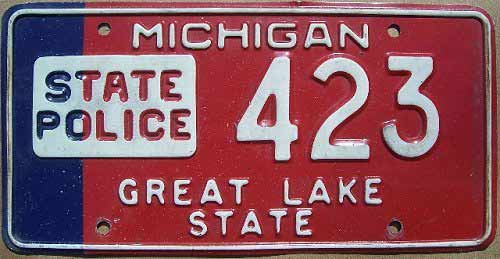 1976-1989 issue. District 4 Post 2 (Clinton) Car 3
1976-1989 issue. District 4 Post 2 (Clinton) Car 3
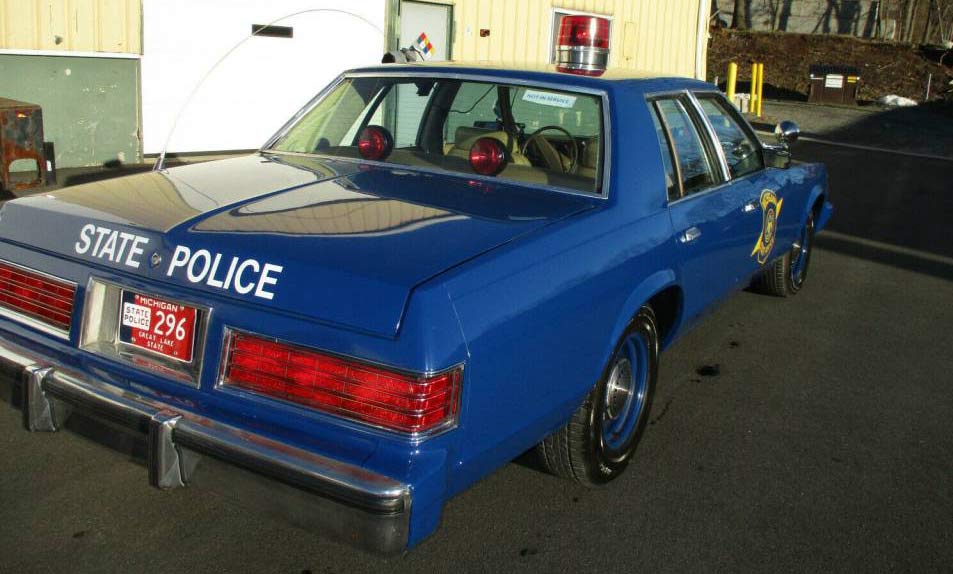
 1976-1989 issue.
1976-1989 issue.  Post 51 (Paw Paw) Car 13
Post 51 (Paw Paw) Car 13
 1976-1989 issue. Canine Handler Post 11 (Lansing)
1976-1989 issue. Canine Handler Post 11 (Lansing) 1976-1989 issue.
1976-1989 issue.  Canine Handler for Post 46
Canine Handler for Post 46 
 1976-1989 issue.
1976-1989 issue.
 1976-1989 issue.
1976-1989 issue. 

 1976-1989 issue.
1976-1989 issue. 

 1976-1989 issue.
1976-1989 issue. 
By 1986, the red white and blue MSP license plates dropped the embossed white-painted border and went to a step border.
The format and color otherwise remained the same until 1989.
 1986-1989 issue. District 6- Post 3 (Mt.Pleasant) Car 4.
1986-1989 issue. District 6- Post 3 (Mt.Pleasant) Car 4.  Niles Post- Car 11
Niles Post- Car 11
 1986-1989 issue. District 3- Post 7 (Bridgeport) Car 10
1986-1989 issue. District 3- Post 7 (Bridgeport) Car 10 Post 51 (Paw Paw) Car 14
Post 51 (Paw Paw) Car 14 1986-1989 issue. Embossed aluminum
1986-1989 issue. Embossed aluminum
In early April of 1989, the Michigan State Police went "Back to the Future" with their license plate design and layout by re-issuing the maize yellow over dark blue plates. The maize yellow paint was coated with a reflective material. These plates were embossed aluminum and utilized a step border. The first of these new plates was issued to the New Buffalo Team (Post 54).
These plates were introduced as new fleet replacements only until after all the red white and blue stock had been exhausted.
As a result, the red white and blue MSP plates were run well into the mid to late 1990's in some parts of the state. It was also with this base that the following additional two letter prefix codes were introduced before this issue got changed-out in 2007 :
D ### District Commander
PD ## Personnel Division
After 2006:
BS ## Bomb Squad
UB ## Uniform Branch
It also must be noted that during this time, some MSP vehicles assigned to the Training Division utilized white over blue Michigan STATE OWNED license plates bearing the TD-## numbering format.
 1989-2007 issue. District 7- Post 9 (Kalkaska Team) Car 1
1989-2007 issue. District 7- Post 9 (Kalkaska Team) Car 1 1989-2007 issue. District 4- Post 6 (Battle Creek) Car 10
1989-2007 issue. District 4- Post 6 (Battle Creek) Car 10
 1989-2007 issue. District 2- Post 9 (Detroit) Car 37
1989-2007 issue. District 2- Post 9 (Detroit) Car 37 Post 12 (Brighton) Car 15
Post 12 (Brighton) Car 15 1989-2007 issue. District Commander
1989-2007 issue. District Commander
 MSP license plates that had a zero after the district number were assigned to SSP Mustangs on this base plate.
MSP license plates that had a zero after the district number were assigned to SSP Mustangs on this base plate.



 Personnel Division
Personnel Division Post 24 (New Baltimore- NOW DEFUNCT) Car 32
Post 24 (New Baltimore- NOW DEFUNCT) Car 32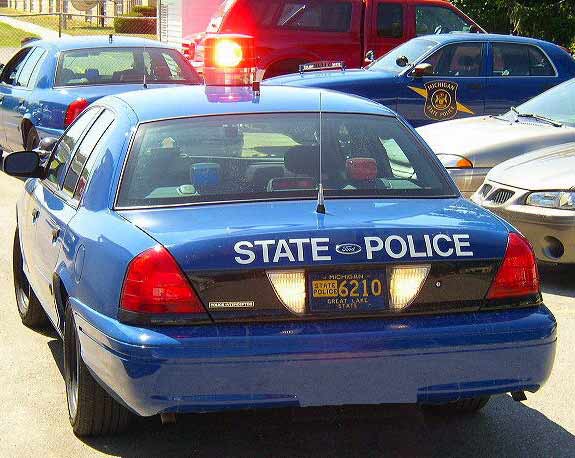 Post 62 (Reed City) Car 10
Post 62 (Reed City) Car 10
 Personnel Division
Personnel Division 1989-2007 issue.
1989-2007 issue. 

 1989-2007 issue. District 6- Post 2 (Hart) Car 3
1989-2007 issue. District 6- Post 2 (Hart) Car 3
 1989-2007 issue. District 6- Post 4 (Grand Haven) Car 3
1989-2007 issue. District 6- Post 4 (Grand Haven) Car 3

 1984-2006 STATE OWNED issue.
1984-2006 STATE OWNED issue.



Prior to the next big MSP license plate changeover in 2007, a variation on the 1989 style plates took place, but it is unknown if this change was specific only to the examples shown below, or if it was a general style change. Some Training Division MSP cars bore license plates in the same color as the regular 1989 issue but without the state name or state slogan. The dies used for the TD prefix and the two numerals were smaller and mitered in design similar to the older Florida dies of the 1960's and early 1970's. The STATE POLICE "box" also used a different font for the lettering. There is no known usage of this type of license plate for any MSP vehicles used outside of the Training Division.
 Circa 2006-2007 issue using smaller mitered dies, removal of state name and state slogan. Change in die font for STATE POLICE. No known issuance beyond Training Division cars seen at MSP Precision Driving Facility.
Circa 2006-2007 issue using smaller mitered dies, removal of state name and state slogan. Change in die font for STATE POLICE. No known issuance beyond Training Division cars seen at MSP Precision Driving Facility.
 Circa 2006 issue. Bomb Squad. Larger mitered dies for numerals. Different die font for STATE POLICE
Circa 2006 issue. Bomb Squad. Larger mitered dies for numerals. Different die font for STATE POLICE

 Circa 2006 issue. Uniform Branch
Circa 2006 issue. Uniform Branch
 Plate reads 02ES-
Plate reads 02ES- 

2007 saw the launch of a brand new graphic license plate for the Michigan State Police. The new plates were a radical departure from previous designs. The new plates were once again made of embossed aluminum and consisted of a reflective white background. The top of the plate sported a blue band which spanned the length of the plate and was wide enough to cover the recessed sticker navel located in the top right corner of the plate. MICHIGAN was silkscreened in white between the upper mounting holes. The MSP emblem was silkscreened to the left of the embossed numerals. The Michigan state internet website address www.Michigan.gov was silkscreened in blue at the bottom center of the plate.
The style was replaced by the "Pure Michigan" base in 2013, however this base was still used on MSP vehicles until miled-out.
These plates and all MSP plates hereafter became four digit plates regardless of how early in the series, with lead zeroes after the Post number (ie: 1201, 3503, 6109)
The District and Post designations for the MSP during this time were as follows:
DISTRICT 1: 11 Lansing, 12 Brighton, 13 Jackson, 14 Monroe
DISTRICT 2: 21 Metro (Oak Park)
DISTRICT 3: 31 Tri City (Freeland), 32 West Branch. 33 Caro, 34 Lapeer, 35 Flint
DISTRICT 4 : DEFUNCT
DISTRICT 5: 51 Paw Paw, 52 Wayland, 53 Niles, 54 Coldwater
DISTRICT 6: 61 Rockford, 62 Hart, 63 Mt. Pleasant, 64 Lakeview
DISTRICT 7: 71 Cadillac, 72 Houghton Lake, 73 Gaylord, 74 Alpena
DISTRICT 8: 81 Negaunee, 82 Sault Ste. Marie, 83 St. Ignace, 84 Gladstone, 85 Iron Mountain, 86 Wakefield, 87 Calumet
The AR designation was added for this base and assigned to Accident Reconstruction units.

 2007-2013 issue. District 2.
2007-2013 issue. District 2. 
 St Ignace Post (83) with Sgt Mike Powell (#6) still using 2007-2013 base plate on August 14 2016.
St Ignace Post (83) with Sgt Mike Powell (#6) still using 2007-2013 base plate on August 14 2016.
 2007-2013 issue.
2007-2013 issue. 
 2007-2013 issue.
2007-2013 issue.  BS 30
BS 30 2007-2013 issue.
2007-2013 issue. 

 16 Designation: State Capitol
16 Designation: State CapitolIn 2013, the state of Michigan was in a new state promotion campaign for "Pure Michigan".
A new license plate design was launched as a result.
The plate was still a step-bordered reflective white plate with dark blue embossed numerals.
The slogan "PURE MICHIGAN" was silkscreened in medium blue at the top center of the plate.
A Medium blue "wave" appears along the bottom span of the plate with "michigan.org" inscribed in white at the lower center portion of the plate. The Michigan State Police shield graphic is screened to the left of the embossed characters.
The post number and special unit prefixes remained the same as the 2007 issue.
This series was also strictly a four digit number series. Although the number of MSP Posts have diminished since 2007 and into 2015, the number of vehicles assigned to the remaining posts has increased to the point of defunct post numbers being re-issued just to have enough plates to be assigned to MSP vehicles. This is also being done to eliminate the need to issue 5 digit plates. Thanks to Mike Moorman for this information.
It was also around this time when the Michigan State Police once again made some Post changes.
Notable was the addition of Post 22 (Metro South-Taylor), Post 54 became Marshall, Post 61 became Grand Rapids, Post 75 created for Traverse City
FIRST DISTRICT (Central) Headquartered in Lansing
Post #11: Lansing
Post #12: Brighton
Post #13: Jackson
Post #14: Monroe
SECOND DISTRICT (Metro) Headquartered in Detroit
Post #21 Metro North (Oak Park)
Post #22 Metro South (Taylor)
THIRD DISTRICT (Thumb and Tri-Cities) Headquartered in Flint
Post #31 (Freeland)
Post #32 (West Branch)
Post #33 (Caro)
Post #34 (Lapeer)
Post #35 (Flint)
FOURTH DISTRICT (STILL DEFUNCT)
FIFTH DISTRICT (Southwest) Headquartered in Paw Paw
Post #51 (Paw Paw)
Post #52 (Wayland)
Post #53 (Niles)
Post #54 (Marshall)
SIXTH DISTRICT (West) Headquartered in Grand Rapids
Post #61 (Grand Rapids)
Post #62 (Hart)
Post #63 (Mount Pleasant)
Post #64 (Lakeview)
SEVENTH DISTRICT (Northern Lower Peninsula) Headquarters in Gaylord
Post #71 (Cadillac)
Post #72 (Houghton Lake)
Post #73 (Gaylord)
Post #74 (Alpena)
Post#75 (Traverse City)
EIGHTH DISTRICT (Upper Peninsula) Headquartered in Marquette
Post #81 (Negaunee)
Post #82 (Sault Ste. Marie)
Post #83 (St. Ignace)
Post #84 (Gladstone)
Post #85 (Iron Mountain)
Post #86 (Wakefield)
Post #87 (Calumet)
 2017 Dodge Charger in MSP Centennial "Retro" livery.
2017 Dodge Charger in MSP Centennial "Retro" livery. 2017 Dodge Charger in MSP Centennial "Retro" livery.
2017 Dodge Charger in MSP Centennial "Retro" livery.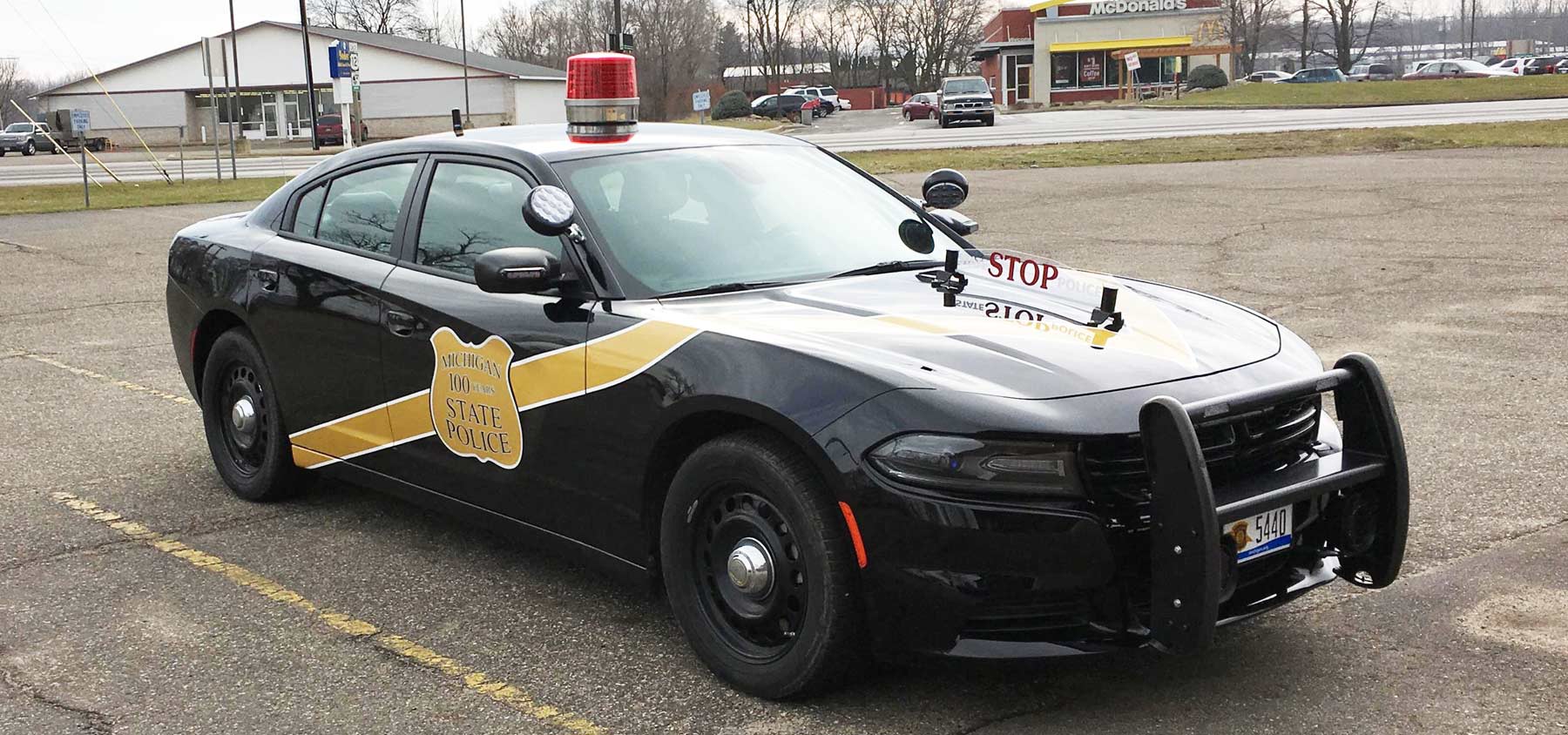
 2017 Centennial Anniversary Car issue.
2017 Centennial Anniversary Car issue.
 (Courtesy Jason Stone)
(Courtesy Jason Stone) 2013-Current issue.
2013-Current issue. 
 2013-Current issue.
2013-Current issue.
 2013-Current issue.
2013-Current issue. 
 2013-Current Emergency Services Team
2013-Current Emergency Services Team  2013-Current issue
2013-Current issue 2013-Current issue.
2013-Current issue.  2013-Current issue
2013-Current issue (Courtesy Sarah Krebs)
(Courtesy Sarah Krebs)  MCV-3
MCV-3  2013-current issue.
2013-current issue.
 2013-Current issue.
2013-Current issue.
 2013-Current issue.
2013-Current issue. SP 63 (2023)
SP 63 (2023)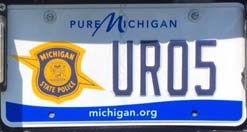 2013-Current issue.
2013-Current issue. 
 2013-Current issue.
2013-Current issue. 
 2013-Current State Vehicle issue
2013-Current State Vehicle issue  MSP Tahoe not assigned to particular Post or Special Unit
MSP Tahoe not assigned to particular Post or Special Unit 
 2024- Training Academy
2024- Training Academy 2020-Current HISTORICAL issue for restored 1975 MSP Plymouth Gran Fury.
2020-Current HISTORICAL issue for restored 1975 MSP Plymouth Gran Fury.
 The Michigan State Police Motor Carrier Division, more recently known as The Commercial Vehicle Enforcement Division (CVED) is responsible for the staffing and operation of 14 scale facilities and conducts road patrol activities focused on commercial vehicle enforcement, e.g., enforcement related to traffic, commercial vehicle drivers and equipment, size and weight, hazardous materials transportation and regulatory requirements. Additionally, the division's commercial vehicle enforcement responsibilities include conducting federal compliance reviews and investigations, school bus inspections, commercial vehicle training for division personnel as well as local and county law enforcement officers and conducting new entrant safety audits. Currently CVED has 104 motor carrier officers, 7 investigators, 4 safety auditors and 10 school bus inspectors. Enforcement responsibilities involving commercial vehicles are, but not limited to, the following areas: General state laws, Equipment requirements, Driver qualifications, Transportation of hazardous materials and Unlawful transportation.
The Michigan State Police Motor Carrier Division, more recently known as The Commercial Vehicle Enforcement Division (CVED) is responsible for the staffing and operation of 14 scale facilities and conducts road patrol activities focused on commercial vehicle enforcement, e.g., enforcement related to traffic, commercial vehicle drivers and equipment, size and weight, hazardous materials transportation and regulatory requirements. Additionally, the division's commercial vehicle enforcement responsibilities include conducting federal compliance reviews and investigations, school bus inspections, commercial vehicle training for division personnel as well as local and county law enforcement officers and conducting new entrant safety audits. Currently CVED has 104 motor carrier officers, 7 investigators, 4 safety auditors and 10 school bus inspectors. Enforcement responsibilities involving commercial vehicles are, but not limited to, the following areas: General state laws, Equipment requirements, Driver qualifications, Transportation of hazardous materials and Unlawful transportation.
Motor carrier officers conduct high visibility traffic enforcement, homeland security, and infrastructure protection through commercial vehicle enforcement activities.
MSP Motor Carrier Division vehicles sported standard MSP license plates with the number 9 following the Post number designation. Numbers began at 90 until approximately 2022/2023 when that designation changed to 80.
 1976-1989 Motor Carrier Division.
1976-1989 Motor Carrier Division. 
 1989-2007 Motor Carrier Officer Division. District 4 Post 5 (Jonesville)
1989-2007 Motor Carrier Officer Division. District 4 Post 5 (Jonesville) District 7- Post 1 (Traverse City)
District 7- Post 1 (Traverse City) 

The exact date is not known, but sometime around 2022/2023, the Motor Carrier Officers of the MSP were amalgamated into the Commercial Vehicle Enforcement Division.
Part of that evolution was the change in the numbering of the MSP license plates for these officers. The previous "90 designation" after the District and Post number was now an "80 designation".
 New Commercial Vehicle Enforcement Division numbering using 80 designation instead of 90.
New Commercial Vehicle Enforcement Division numbering using 80 designation instead of 90. Post 13 (Jackson) CVE 7
Post 13 (Jackson) CVE 7
The Michigan State Police began utilizing motorcycles for patrol enforcement activities in 1922. It is believed that they used regular Michigan motorcycle license plates on the rear of the cycles up until 1927.
Front fender plates were used with STATE POLICE and a small assignment number painted below on both sides.
In 1927, it's been stated that the MSP were issued embossed steel plates painted in white over black, but size unknown and run rear only. The left side of the plate had MICH over 1927 followed by STATE over POLICE in the center and followed by an embossed number to the right side.
As with MSP car license plates, it can be surmised that the white over black license plates were issued annually with slight variances in positioning of characters.
The only other known photo of an MSP motorcycle license plate from this era is a couple of 1939 examples shown in a Michigan State Archives photo where MSP mechanics are seen repairing motorcycles at East Lansing Headquarters garage. These plates appear to be approximately 3 1/2" x 7" and embossed steel. They are painted in white over black. The left portion of the plate has the abbreviation MICH over 1939 over the number (30 and 31) followed by STATE over POLICE occupying the center and right portion of the plate.
Otherwise, there is no other information at this time with respect to MSP motorcycle license plate usage until the 1970's.




 (Courtesy Bob Blickensdorf)
(Courtesy Bob Blickensdorf) Circa 1970's. 4" x 7".
Circa 1970's. 4" x 7". 
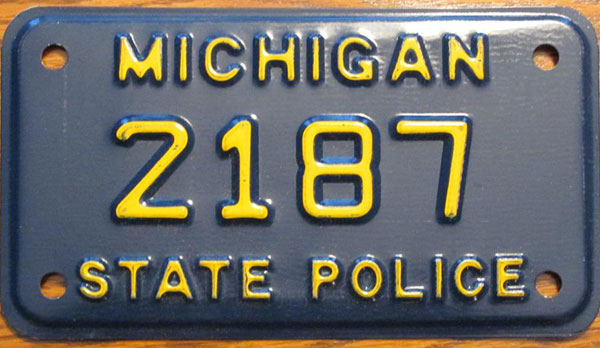 1989-2007 issue.
1989-2007 issue. 
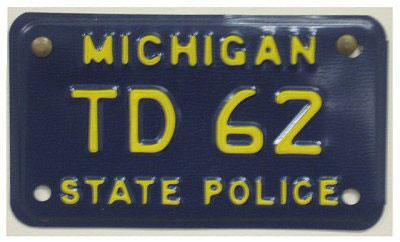 1989-2007 issue.
1989-2007 issue. 

 2007-2013 issue for motorcycle. District 2. Post 5 for Flat Rock no longer exists, so this number may only be sequential and not related to a given Post.
2007-2013 issue for motorcycle. District 2. Post 5 for Flat Rock no longer exists, so this number may only be sequential and not related to a given Post.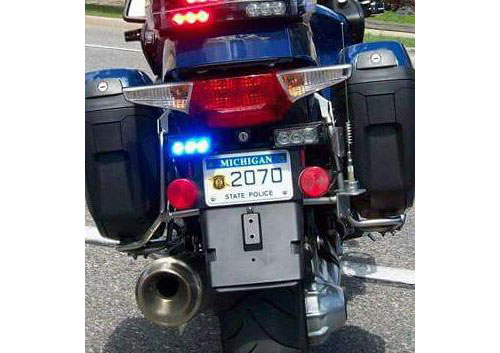 (Courtesy Darrell Thompson)
(Courtesy Darrell Thompson) (Courtesy Jason Stone)
(Courtesy Jason Stone)  2013-Current issue.
2013-Current issue. 10/8/2018 the day of the motorcycle license plate swithchover to M plates.
10/8/2018 the day of the motorcycle license plate swithchover to M plates. 2018-Current motorcycle issue.
2018-Current motorcycle issue.Some special types of Michigan State Police license plates have been made but not issued for official use. The following plates are such examples.
 Michigan Traffic Signal Permit
Michigan Traffic Signal Permit 1971-1972.
1971-1972. 1976-1989 Paint Test plate.
1976-1989 Paint Test plate.  Potential 1976-1978 reserved MSP prefix for personal use similar to confirmed MSP prefix plates used in 1984-1985 for personal vehicles of MSP troopers.
Potential 1976-1978 reserved MSP prefix for personal use similar to confirmed MSP prefix plates used in 1984-1985 for personal vehicles of MSP troopers. Back in 1984 and 1985, MSP personnel were given the opportunity to register their personal vehicles with MSP suffixed passenger license plates.
Back in 1984 and 1985, MSP personnel were given the opportunity to register their personal vehicles with MSP suffixed passenger license plates.  Personalized with a Bad Axe Post number 8 designation.
Personalized with a Bad Axe Post number 8 designation. Special 75th Anniversary Souvenir issue made on 1989-2007 base plate.
Special 75th Anniversary Souvenir issue made on 1989-2007 base plate. Special 75th Anniversary Souvenir issue made on 2006 test type base plate with reflective white background.
Special 75th Anniversary Souvenir issue made on 2006 test type base plate with reflective white background. 2006 test/prototype issue. A select batch of these non-titled graphic dark blue over reflective white license plates were made with badge numbers prior to the full design choice selected for the 2007 issue.
2006 test/prototype issue. A select batch of these non-titled graphic dark blue over reflective white license plates were made with badge numbers prior to the full design choice selected for the 2007 issue. 2006 test/prototype issue with state name and STATE POLICE.
2006 test/prototype issue with state name and STATE POLICE. Michigan State Troopers Association issue. Silkscreened aluminum
Michigan State Troopers Association issue. Silkscreened aluminum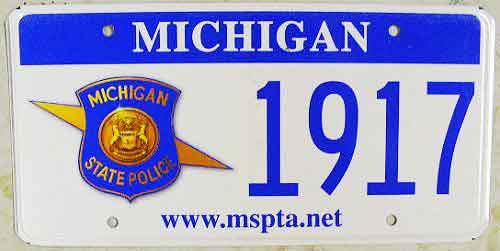 Michigan State Troopers Association issue.
Michigan State Troopers Association issue.  Personalized personal vehicle issue comemmorating the MSP 86th Recruit Class.
Personalized personal vehicle issue comemmorating the MSP 86th Recruit Class. Personalized personal vehicle issue.
Personalized personal vehicle issue. National Troopers Coalition Souvenir plate.
National Troopers Coalition Souvenir plate. 2007-2013 personalized issue.
2007-2013 personalized issue.  Michigan Department of Corrections graphic prototype.
Michigan Department of Corrections graphic prototype. Commemorative private issue.
Commemorative private issue.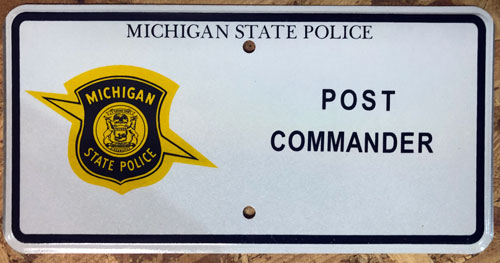 Prototype Post Commander Parking Sign
Prototype Post Commander Parking Sign